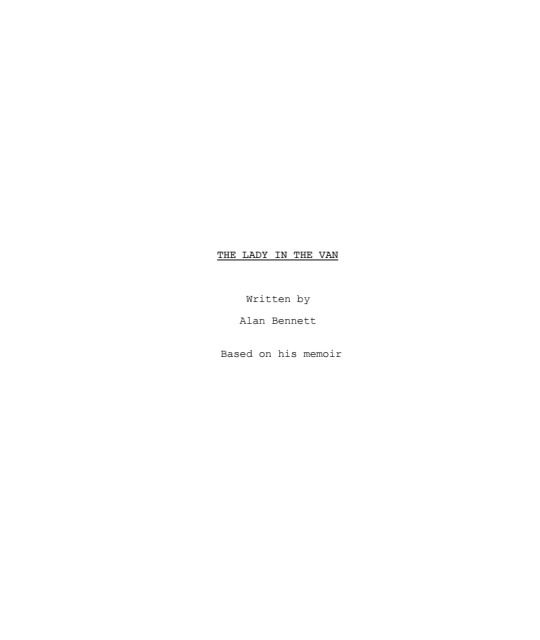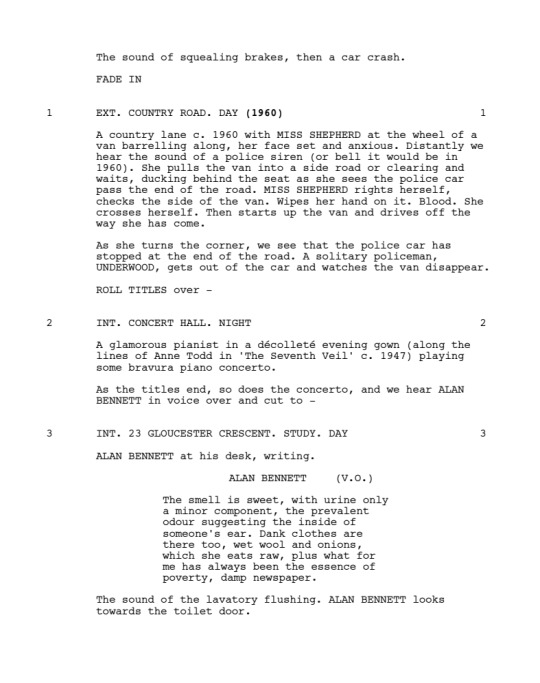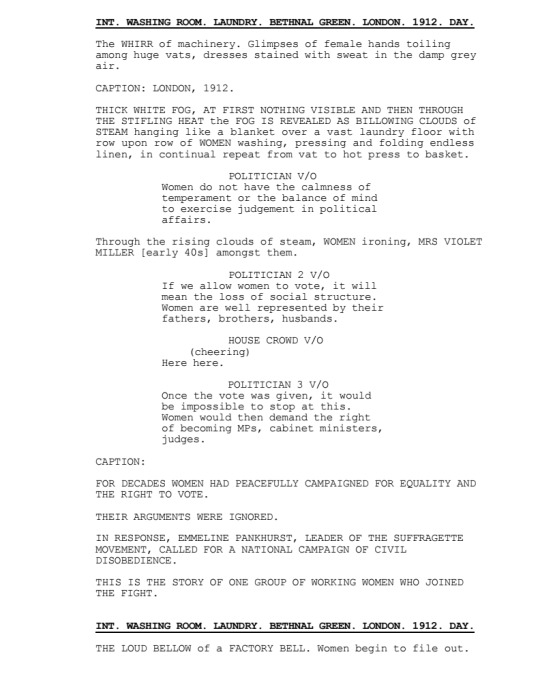Text
Index
Creative Investigation
Planning 1
Planning 2
First Edit
0 notes
Video
youtube
My first film draft. There isn’t much footage, but I’d say that these shots summarize the tone found in the start of my film quite well.
0 notes
Text
Secondary Source 15
Name of Book / Magazine: Mother: Interview with Bong Joon-ho
Author: Unknown
Publisher, place of publication and date: Electric Sheep Magazine, 1 August, 2010
Title of chapter / article: N/A
Page numbers used: N/A
Web address used to access source: http://www.electricsheepmagazine.co.uk/features/2010/08/01/mother-interview-with-bong-joon-ho-2/
Date Accessed: 14/03/18
Your research topic / question: Auteur Theory
Brief overview of what the article / chapter / book is about: An interview with Bong Joon-ho about his new film, Mother.
Key quotes from article / chapter / book that relate to your topic:
“How is your relationship to your own mother? Did she serve as an inspiration here?
Well, she didn’t kill anybody [laughs]. Actually, she hasn’t seen the movie yet, and I am very excited but also a little bit worried because she also has a tendency to obsession. I mean, I am 40 years old and she is still constantly worried about me. So, yes, in some way my mother also inspired me in making the film I guess, but not primarily. And don’t tell her I said that.”
0 notes
Text
Secondary Source 14
Name of Book / Magazine: Korean Film Directors: Bong Joon-ho
Author: Jung Ji-youn
Publisher, place of publication and date: Korean Film Council, 2008
Title of chapter / article: Interview - Memories of Murder
Page numbers used: 98-107
Web address used to access source: N/A
Date Accessed: 29/11/17
Your research topic / question: Auteur Theory
Brief overview of what the article / chapter / book is about: An interview with Bong Joon-ho about his filmography. (Originally conducted in 2008)
Key quotes from article / chapter / book that relate to your topic:
“For my next film, I’m going to try making what I’ve liked the most ever since I was a kid. So I naturally came up with a crime film, and as I was thinking that I should try and do it in a realistic and Korean-style method rather than imitating American genre films. I thought of the Hwaeseong murders, which I’d heard a lot about since I was young. But when I actually researched data on the Hwaeseong murders, it contained elements that were far more overwhelming and horrific than I had ever imagined.”
Shows a deep insight behind the reason for Bong’s interest in making Memories of Murder. Combining one of his favourite film genres from when he was young and implementing a real life issue that he felt affected by shows a lot of true interior meaning behind the film.
“I met with detectives who worked the case, Hwaeseong residents, and reporters from the Gyeongin Ilbo, which was the region’s newspaper.”
Shows the extensive research and attention to detail that went into the making of Memories of Murder.
“I was very scared. I suffered a lot psychologically. Really, during that time period, I was very deeply absorbed in the murders, enough so that I had delusions that I might capture the real killer in the process of my research. I fell deeply into it emotionally, so I was exhausted as well.”
Implies how far Bong took his research. Arguably too far, but makes the raw emotions that take place within the film feel more genuine and intended than just a thing that happens because the narrative has been dramatised or manipulated to make the audience feel certain emotions.
“Were there any serial killer films you consulted when you wrote the script?”
“I watched a lot of them, things like Se7en and The Silence of the Lambs. And also Imamura Shohei’s Vengeance Is Mine. Not only does that film clearly reveal hysteria in the Japanese society of the time, it has some unidentifiable, incredible strength to it. Of course, the work that influenced Memories of Murder directly was Alan Moore’s graphic novel From Hell. I was a bit disappointed with the Hughes brothers’ film of it.”
Exposes lots of influencing films and even a book that helped in the making of Memories of Murder. Could either strengthen or degrade Bong’s eligibility as an auteur!
0 notes
Text
Collated Quotes
Subtopic 1: Is there a clear sense of authorship across Bong’s films?
“The expansive progress of Bong’s filmography through the Host and Snowpiercer has made it very clear that the Korean director has the imagination and technical chops to create a fantasy cinema on a level with anything from the Hollywood mainstream, but a sensibility with no taste for the blockbuster production line’s easy reassurance.”
“The bittersweet finale also flags up the challenges ahead in providing a harvest for the expanding world, so no platitudinous solutions here, just a movie that showcases Bong’s admirable flair for artfully unhinged spectacle, deftly undercut by a chastening reality check that never allows us to enjoy ourselves too much.”
“A repeated image shows the girl leaning into the pig’s floppy ear and whispering to calm her down. We never hear exactly what she’s whispering, but the tight closeups of Okja’s mesmerized eye show us that she’s listening intently and gets the gist—that the girl’s words matter and make sense even though they don’t speak the same language. The pig trusts her friend. All the film’s many threads ultimately come back to questions of trust: what it means to keep it or betray trust, and whether there are circumstances where betrayal is necessary, and whether the trust between human and human is more meaningful than the trust between human and animal. Mija would tell you there’s no difference.”
“He’s also a filmmaker who finds great, unsettling dark comedy in violence, and once again the blood does run, if somewhat less generously than in “The Host” and his often brilliant “Memories of Murder.”
“Mr. Bong’s virtues as a filmmaker, including his snaking storytelling and refusal to overexplain actions and behaviors, can here feel like evasions or indulgences rather than fully thought-out choices. There’s a vagueness to the film that doesn’t feel organic — as if, having created a powerhouse central character, he didn’t exactly know what to do with her. That said, his visual style and the way he mixes eccentric types with the more banal, like a chemist preparing a combustible formula, are often sublime, as is Ms. Kim’s turn as the mother of all nightmarish mothers, a dreadful manifestation of a love so consuming it all but swallows the world.”
“Okja is the Korean director’s most accessible film to global audiences to date, a near masterpiece that bends and twists genres and celebrates childhood even when it goes into some rather dark places along its still consistently childlike adventures.“
“Bong’s movies deny the easy satisfaction of an overarching victory, instead suggesting that you can’t save a world that may have already doomed itself.”
“I have admired Bong Joon-ho’s works for many reasons, and one of them is the unpredictability of his choices. He made me both laugh and cringe in a deadpan black comedy “Barking Dogs Never Bite” (2000), and then he played me like a piano in his great rural-set thriller film “Memories of Murder” (2003), and then he surprised me with monster film “The Host” (2006), and then he came back to another thriller set in the countryside in “Mother” (2009).”
“ …twisting suddenly from horror to pathos to comedy to action and back again… “
“His films are never about straight good versus evil; there’s never a particular heroic sense of triumph to be found. Yet, neither is he a filmmaker who revels in pessimistic brutality. Even in the darkest of moments, there’s always a spark of hope to be found.”
“Even the characters I create, they aren’t clear-cut supervillains or superheroes, they’re all residing in the grey area. Maybe that’s why a certain amount of optimism or pessimism mixes into my films. I do feel, however, that’s more realistic and more reflective of how society is, and how life is. If everything is clear-cut and residing in one direction, it might feel a bit forced.”
“Because Netflix isn’t pursuing a theatrical release in France, the President of the esteemed film festival nearly pulled both Netflix films in competition (Okja and Noah Baumbach‘s The Meyerowitz Stories). Though they screened (and received some of the best reviews from the festival), the Jury held steadfast on the prediction that they would not reward any of the streaming service’s films. Despite this future-of-cinema conversation, the streaming distributor has offered Bong much more creative control than his English-language debut, Snowpiercer, where he had a constant battle with The Weinstein Company over the cut. Indeed, he’s quite pleased with his experience this go-round and that freedom will only make Netflix more enticing for filmmakers.“
“The Host begins with the American company just saying “dump everything down the drain”. This one is behind the scenes but it has very similar effect…it’s all this pageantry around it as if they’re doing something good when really they’re just dumping things down the drain, as well. Were you wanting to explore that idea in a different way?
BONG: This time I want to portray that idea via Tilda, who plays two roles. With Nancy Mirado, like in The Host, I wanted to be very explicit with the violence that she inflicts. Whereas Lucy Mirado, she tries to differ from Nancy. She thinks that she’s more elegant, more eco-friendly; she’s more obsessed with the marketing aspect of it and how it looks on the exterior. Nevertheless, the winner within the Mirando group is Nancy, not Lucy, and I think that reflects my concerns and fears about the reality of multinational companies within capitalist societies. The more ruthless people almost always seem to take over.”
“The traditional studios were a bit skeptical or a bit overly conscious about the radicalness of the script, and they weren’t on board,” he said. “From the get-go, it was guaranteed creative freedom [with Netflix]. They weren’t meddling with any part of the filmmaking whatsoever.”
Subtopic 2: Are Bong’s films personal to him?
“To their credit, the moviemakers signal right away that this isn’t a film that adults can use as an electronic babysitter. The dialogue is liberally peppered with F-words, and the more exaggerated jokes about corporate hypocrisy are reminiscent of non-child friendly satires like “Dr. Strangelove” and “Network” (upon learning that it will take ten years for the pigs to grow, a reporter moans, “Jesus Christ—I’ll be dead by then!”). There are also visual and thematic nods to cartoonist turned director Terry Gilliam, who made films that were childlike and sometimes childish but never strictly for kids—in particular the 1985 anti-fascist fable “Brazil,” which appears to have inspired the derring-do of ALF’s membership, chivalrous rebels who evade police by diving off bridges”
“…Delightful, winning and deliriously wonderful story that unfolds is part E.T., part Bong Joon Ho, part Swiss Army Man (Seriously!), and ultimately one of the year’s most pleasant cinematic surprises.
“The movie’s underlying premise — child bonds with otherworldly beast and defends it from cruel adults — easily calls to mind “E.T.” or “Pete’s Dragon,” but Bong bends the formula into his own agenda.”
“It’s the recombinant offspring of all those science-fiction pictures of the 1950s and ‘60s in which exposure to atomic radiation (often referred to as both “atomic” and “radiation”) or hazardous chemicals (sometimes also radioactive) results in something very large and inhospitable: “Them!” (giant ants), “Tarantula” (giant spider), “Matango: Attack of the Mushroom People” (giant fungi), “The Amazing Colossal Man” (giant bald guy), “The Giant Behemoth” (giant behemoth – both giant and a behemoth, but more precisely a radioactive ocean-dwelling Godzilla clone), “Frankenstein Conquers the World” (giant Frankenstein’s monster atomically regenerated from the beating heart of the original monster after the A-bomb is dropped on Hiroshima), and so on.“
“Joon-Ho Bong implies that media and government are equally incompetent and untrustworthy. When you need saving from the maw of a mutant river beast, you’ve got nowhere to turn but your kin.”
“I think that films aren’t necessarily tools to change the world, a film is just a beautiful thing in itself. However, when someone is experiencing the beauty of a film, that itself is changing the world in some aspect.”
“I don’t expect the entire audience to convert to veganism after watching the film. I don’t have a problem with meat consumption itself, but I do want my audience to consider, at least once, where the food on their plate comes from. And, if one is to do that, I believe the level of meat consumption will gradually decline.”
“The South Korean director’s films, in the cinematic landscape, have never really been considered outright political missives, perhaps only because they hide under the guise of genre film.”
“However, although the super-pig phenomenon may be fiction at the moment, it’s very close to being a reality. In Canada, they already made some kind of GM salmon. It’s already gotten FDA approval. They are starting to very carefully distribute it in the market. In the process of researching the film, I met and interviewed a PhD student who is developing a GM pig. So, Okja is real. It’s actually happening. That’s why I rushed making Okja, because the real product is coming.”
“Even the characters I create, they aren’t clear-cut supervillains or superheroes, they’re all residing in the grey area. Maybe that’s why a certain amount of optimism or pessimism mixes into my films. I do feel, however, that’s more realistic and more reflective of how society is, and how life is. If everything is clear-cut and residing in one direction, it might feel a bit forced.”
“I was always a huge film buff. I was a child of the ’70s, so I didn’t have access to DVDs or VHS growing up. I didn’t go to the movies that often either. In many ways, TV was my cinema. I would open up the TV schedule and see what movies were playing each week. Although I was mostly watching films on TV, I could get through around ten a week. By the time I got to middle school, I was certain that I wanted to become a film director.“
“I majored in sociology in college. I knew that my parents would disapprove of me studying film.”
“For my next film, I’m going to try making what I’ve liked the most ever since I was a kid. So I naturally came up with a crime film, and as I was thinking that I should try and do it in a realistic and Korean-style method rather than imitating American genre films. I thought of the Hwaeseong murders, which I’d heard a lot about since I was young. But when I actually researched data on the Hwaeseong murders, it contained elements that were far more overwhelming and horrific than I had ever imagined.”
“I met with detectives who worked the case, Hwaeseong residents, and reporters from the Gyeongin Ilbo, which was the region’s newspaper.”
“I was very scared. I suffered a lot psychologically. Really, during that time period, I was very deeply absorbed in the murders, enough so that I had delusions that I might capture the real killer in the process of my research. I fell deeply into it emotionally, so I was exhausted as well.”
“I watched a lot of them, things like Se7en and The Silence of the Lambs. And also Imamura Shohei’s Vengeance Is Mine. Not only does that film clearly reveal hysteria in the Japanese society of the time, it has some unidentifiable, incredible strength to it. Of course, the work that influenced Memories of Murder directly was Alan Moore’s graphic novel From Hell. I was a bit disappointed with the Hughes brothers’ film of it.”
Subtopic 3: To what extent has Bong collaborated with the same people time and time again?
“Bong Joon Ho co-writes the film with British author/journalist Jon Ronson, a partnership that perfectly weaves together the director’s marvelous creature sensibilities, as previously experienced in The Host, with Ronson’s ability to convey a Brit-like humor and wit throughout the film that is intelligent, sensitive and, at times, quite darkly hilarious.”
“Zipping along to a vibrant soundtrack, Bong crafts lively, action-packed moments that find the hulkish Okja careening through public spaces while people scramble around her. This includes one of the most striking moments in Bong’s entire career — a slow-mo battle set to John Denver’s “You Fill Up My Senses,” which finds the ALF forming a wall of umbrellas to defend a cornered Okja while Mija cowers nearby.”
“Bong Joon-ho and his co-screenplay writer Kelly Masterson (he previously made an impressive debut with Sidney Lumet’s last work “Before the Devil Knows You’re Dead” (2007)) have made a darkly engaging SF thriller from their source.”
“Tilda Swinton gloriously embraces her despicable character with the attitude of mean British headmistress, and she is fearless as usual in throwing herself into the hammy side of her character.”
“But about the monster. Created by the San Francisco-based FX house, The Orphanage, it is a creature of scary amphibious loveliness, with greenish salamanderlike skin, froggy legs…“
“I first met Plan B a long time ago-2007 in LA-and they suggested a lot of original source material to me. It was a very light relationship. It was right after I was done with my film The Host and Jeremy and Brad Pitt from Plan B were fans. I also really admired their filmography. They do lots of cavalier films such as 12 Years a Slave. So it was a natural mix between Plan B and I. But even before Plan B came on board the casting casting and effects of the film were already packaged nicely through the Korean producers and the American producer, Dooho Choi. Plan B came slightly later on and because they had a good relationship with Netflix via War Machine, they introduced Netflix to the film and they were fully supportive of Okja. It was a very smooth transition all around so I am very happy.”
“The Host begins with the American company just saying “dump everything down the drain”. This one is behind the scenes but it has very similar effect…it’s all this pageantry around it as if they’re doing something good when really they’re just dumping things down the drain, as well. Were you wanting to explore that idea in a different way?
BONG: This time I want to portray that idea via Tilda, who plays two roles. With Nancy Mirado, like in The Host, I wanted to be very explicit with the violence that she inflicts. Whereas Lucy Mirado, she tries to differ from Nancy. She thinks that she’s more elegant, more eco-friendly; she’s more obsessed with the marketing aspect of it and how it looks on the exterior. Nevertheless, the winner within the Mirando group is Nancy, not Lucy, and I think that reflects my concerns and fears about the reality of multinational companies within capitalist societies. The more ruthless people almost always seem to take over.”
“After what we went through on the last one, it was very important to start the process knowing that we had control,” producer Dooho Choi said after a press event in Cannes on Sunday. “That was most appealing aspect of it — knowing that he could play, and that someone would not be looking over his shoulder constantly. It was a pretty smooth process in that regard.”
0 notes
Text
Mother Screening Notes
At this point in watching Bong’s films, I’ve noticed that he is rather fond of wheat fields. He seems to consistently use long shots of character’s walking/standing alone in them, but it seems to be for varying purposes.
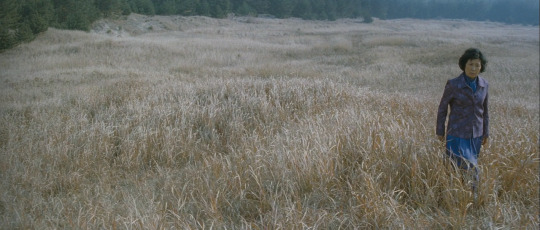
At the beginning of Mother, her standing in the field appears to be at a point in the film where she has burned the witness’ garage down, which is interesting. The use of framing in this shot is very explanatory and is a suitable introduction for her character. She is lonely, she doesn’t seem to have had a good life thus far and the only company she has is that of her son.
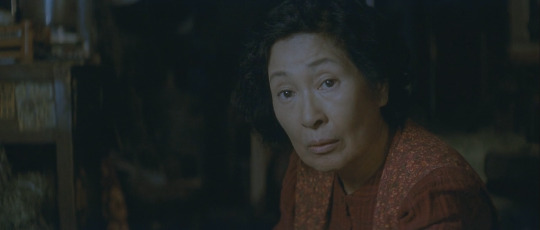


After the intro sequence, Bong uses one of his most famous trademark techniques. Initially, Mother looks over to her son, Yoon Do-joon, before cars passing occupy the foreground, and she cannot see Yoon Do-joon properly for the cars. This is an example of how Bong creates a busy shot to then distract the audience from what’s in the foreground. After a few more cars pass by, Yoon is hit by a car which draws the attention to the background once again. The scene is very cleverly composed of internal framing that is a clear indication of Yoon’s disadvantage in society-he is mentally disabled and appears to be rather oppressed throughout the film.

Although less extreme than the Okja chase scene, Mother still has that signature comical take on violence that all of his other films have. Yoon Do-joon steps out in front of the golf cart carrying the people that ‘hit and run’ him with the intention of fighting them.
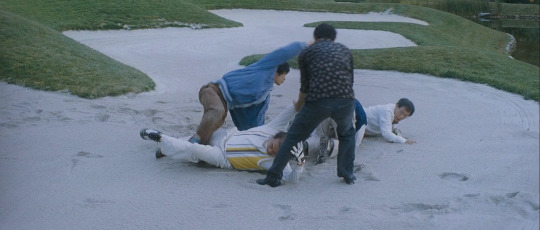
The cart then stops after Yoon’s friend, Jin Goo, throws a stick at it. The men in the golf cart step out and start to run away, but Yoon and Jin begin attacking them with golf clubs and dragging them along the floor. The whole fight scene looks very pathetic and comical and doesn’t communicate a sincere mood, as all of the men are simply flailing around without actually inflicting injury on one another.
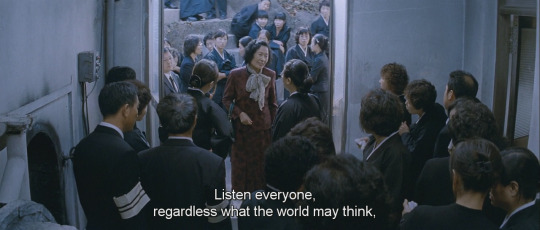
The shot above is yet another example of how Bong makes use of colour throughout his films. Here, Mother is at the funeral of the young girl that was murdered-it is easy to identify her standing out from the crowd because she has attended in a red outfit, whereas everyone around her is dressed in black. This further shows how she may feel although she is against society as she is the only person that believes her son is innocent.
0 notes
Text
Memories of Murder Screening Notes
Memories of Murder Screening Notes
Chase scene
This film has yet another adrenaline pumping chase scene.
Cinematography
Many two and three shots of the three detectives running together, almost in perfect unison. Creates a lack of intelligence and how the detectives may not be thinking about how to catch the suspect cleverly as opposed to just outright chasing him down.
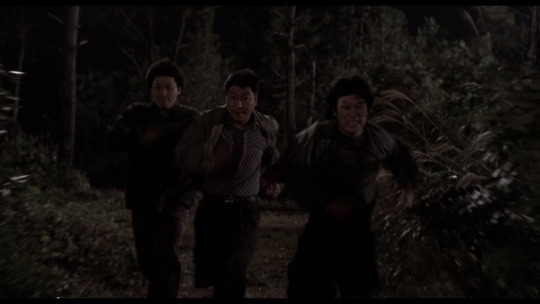
Lots of long tracking or panning shots used without much editing so that the viewer can see every tiny detail of what is happening. As a result, the scene seems slow paced and lengthy which contrasts majorly with what seems to be happening in the film’s reality. This creates a dark, twisted sense of humour when accompanied by the detective’s brainless chasing skills.

Bong uses many extreme long shots where there are many things happening at once and draws the viewer’s attention to certain happenings in the scene, as can be seen in the following shot:

This shot happens during the chase and the suspect runs off into a giant construction site, where there are many workers with the same outfits on. You can see the detectives trying to find the suspect amongst the workers and the audience’s attention is draw to the action in the large shot of many different people. I have identified this amongst many of Bong’s films- he seems to enjoy using long shots with lots of activity and then diverting the audience’s attention in the same shot by having something distracting happen.

Bong is well known for his excessive use of bright colours in his films. Specifically in this shot, the yellows are rather emphasised, creating a beautiful saturated effect but also is suggestive of the film’s rather unsatisfactory demise. In Memories of Murder, the detectives never actually find the serial killer, meaning yellow could have been used to show a rather neutral ending.
0 notes
Text
Synopsis
LOGLINE: Recent advancements in the farming industry now place humans on the chopping block. Mr Placeholder Name is greeted by a rude awakening when his dear beloved is crammed into the back of a van.
Characters:
The story takes place in 2050-the world has become twisted eutopia where humans are farmed for meat instead of animals. ANDREEA has just moved over to the UK from Romania, to live with her auntie (GRETA) and uncle (PHILIP). Andreea meets BEN, who imminently becomes her love interest.
ACT 1:
Andreea has just moved over to the UK from Romania, to live with her auntie and uncle. At her new sixth form she meets Ben, and the two click instantly. Although reluctant to admit they like eachother, they enjoy eachother’s company and begin doing things together, until Andrea notices that Ben is acting strange. She questions Ben but he is reluctant to say anything, and the two argue until Andreea tells Ben to leave.
ACT II:
The following week at college, Andreea notices Ben isn’t there. He doesn’t turn up for the rest of the week. Andreea becomes worried, asking if anyone knows where he has gone, but nobody seems to care. As a last resort, Andreea visits Ben’s parents, who act strangely and ask her to leave.
ACT III:
While she is out, she decides to go shopping, and upon walking down the ‘Ecomeat’ aisle, she eyes the packets suspiciously. She picks up what she needs and gets ready to leave, but not before she notices the door to the meat counter open at the back of the store. She puts her shopping down and sneakily walks in, looking for any packets of ‘Ecomeat’. She sees a long freezer in the corner, and walks over to look at it. Opening the lid, she sees that it is Ben frozen, with parts of his arms and legs sliced off. Dropping the lid shut with shock, she stumbles backwards and begins running. She dodges crowds of people entering the store who eye her in interest. She doesn’t reach the exit of the car park before falling to the ground and vomiting.
0 notes
Text
Post A. Initial Ideas
Narrative
The narrative of my film will primarily focus on restoring the equilibrium, despite the fact that the equilibrium is never actually restored.
I will be exploring the following character types in my film:
Hero - my hero will be attempting to overthrow the government’s decision to begin farming humans instead of animals.
Damsel in distress - is chosen to be farmed and must be saved by the hero.
This structure is similar to the narrative found in Okja-Mija tries to do everything in her power to halt the Mirando Corporation from farming her best friend.
Themes
Man vs. Society - Okja and Mother definitely explore this theme quite a lot. Mija is rising against Mirando for attempting to steal her best friend, and ‘Mother’ is attempting to prove that her son is not guilty of murder.
I was thinking that my film could pick at this theme further, hopefully in a different way to Okja or Mother. I’m thinking of having a more developed character who accepts that society always wins and tries to outsmart it as opposed to rise against it.
Representation
I would like to explore the representation of minority groups and how they would survive in a world where cannibalism is the norm. Different countries especially, that differ in ideologies and values. I am not yet sure of the ages I would like to represent, but having a world where gender is reversed would certainly be interesting (e.g farming males because they do not reproduce, and tend to store more meat puts the disadvantage on males instead of females)
Messages & Values
I want to raise awareness of how farming affects the world. I want my film to put the audience in the shoes of animals that are farmed today and explore the emotional distress and misery that the animals live in,until their demise.
Style
I’m fairly certain that I would like my film to employ a British social realism style, to achieve the jarring effect I’m going for. British social realism films tend to have a very high level of verisimilitude, and if my film can do the same I’m sure it will have more of an emotional impact on the audience.
Authorship
I’m quite interested in creating a mash up between a realistic approach and Bong’s use of comedic chase scenes. I think a chase scene between two binary opposing characters where the weaker character is chasing the stronger character would be interesting to see on screen. I think demonstrating how powerless and weak they are would be symbolic of how powerless Mija is over Okja’s fate.
0 notes
Text
Secondary Source 13
Name of Book / Magazine: Anthem Magazine
Author: Kee Chang
Publisher, place of publication and date: anthemmagazine.com, 13 April 2017
Title of chapter / article: ‘Okja’: THE LOST INTERVIEW: BONG JOON-HO
Page numbers used: N/A
Web address used to access source: http://anthemmagazine.com/the-lost-interview-bong-joon-ho/
Date Accessed: 22/10/17
Your research topic / question: Auteur Theory
Brief overview of what the article / chapter / book is about: An interview with Bong Joon-ho about his filmography. (Originally conducted in 2009)
Key quotes from article / chapter / book that relate to your topic:
“I was always a huge film buff. I was a child of the ’70s, so I didn’t have access to DVDs or VHS growing up. I didn’t go to the movies that often either. In many ways, TV was my cinema. I would open up the TV schedule and see what movies were playing each week. Although I was mostly watching films on TV, I could get through around ten a week. By the time I got to middle school, I was certain that I wanted to become a film director.“
Bong knew he wanted to be a director and he barely even had access to films-he must have a burning passion.
“I majored in sociology in college. I knew that my parents would disapprove of me studying film.”
Bong felt oppressed by Korean norms and had to cover up his dreams, even to the extent of majoring in sociology just to please his parents.
0 notes
Text
References
Cho, S. (2017). Snowpiercer | Far Flungers | Roger Ebert. [online] Rogerebert.com. Available at: http://www.rogerebert.com/far-flung-correspondents/snowpiercer [Accessed 7 Oct. 2017].
Dargis, M. (2017). Bong Joon-ho’s Fierce Love: Better Not Make This Mom Angry. [online] Nytimes.com. Available at: http://www.nytimes.com/2010/03/12/movies/12mother.html [Accessed 27 Sep. 2017].
Emerson, J. (2017). The Host Movie Review & Film Summary (2007) | Roger Ebert. [online] Rogerebert.com. Available at: http://www.rogerebert.com/reviews/the-host-2007 [Accessed 11 Oct. 2017].
Erbland, K. and Kohn, E. (2017). ‘Okja’: How the ‘Snowpiercer’ Experience Inspired Bong Joon Ho’s Move to Netflix. [online] IndieWire. Available at: http://www.indiewire.com/2017/05/okja-snowpiercer-bong-joon-ho-netflix-1201829695/ [Accessed 22 Oct. 2017].
Formo, B. (2017). Bong Joon Ho on Why He Chose a Pig for 'Okja', Working with Netflix. [online] Collider. Available at: http://collider.com/bong-joon-ho-okja-interview-netflix/#story-themes [Accessed 22 Oct. 2017].
Johnston, T. (2017). Okja. Sight & Sound, (July 2017), pp.75, 76.
Kohn, E. (2017). ‘Okja’ Review: Bong Joon Ho Delivers His ‘E.T.’ With Delightful Tale of a Mutant Pig and the Girl Who Loves Her — Cannes 2017. [online] IndieWire. Available at: http://www.indiewire.com/2017/05/okja-review-bong-joon-ho-netflix-cannes-1201828663/ [Accessed 7 Oct. 2017].
Loughrey, C. (2017). Bong Joon-ho on why Netflix's Okja won't be fictional for much longer. [online] The Independent. Available at: http://www.independent.co.uk/arts-entertainment/films/features/okja-interview-bong-joon-ho-release-date-netflix-veganism-vegan-cannes-controversy-a7807771.html [Accessed 16 Oct. 2017].
Propes, R. (2017). The Independent Critic - "Okja" Launches on Netflix on June 28th. [online] Theindependentcritic.com. Available at: http://theindependentcritic.com/okja [Accessed 27 Sep. 2017].
Rayns, T. (2004). Suspicious Minds. Sight & Sound, (September 2004), pp.18, 19, 20.
Seitz, M. (2017). Okja Movie Review & Film Summary (2017) | Roger Ebert. [online] Rogerebert.com. Available at: http://www.rogerebert.com/reviews/okja-2017 [Accessed 27 Sep. 2017].
Stevens, D. (2017). The Host reviewed.. [online] Slate Magazine. Available at: http://www.slate.com/articles/arts/movies/2007/03/beastly_good.html [Accessed 13 Oct. 2017].
0 notes
Text
Okja Screening Notes
Chase Scene
All of Bong’s chase scenes throughout the films that I have seen have been extremely entertaining to watch, as they are usually rather humorous. There are two more chase scenes in Memories or Murder that are quite similar in style.
Cinematography:
(02:16) Lots and lots of fast panning/zooms used, accelerates the scene and creates considerable tension. Zooms are used in a comical way as to not seem too sincere/dramatic.
(02:38) Okja is internally framed inbetween the steps and ceiling. Encourages the comical feeling of the scene. Look at this giant pig trying to squeeze itself into a tiny dollhouse!
(02:40) Rapid tracking. Not only matches the pace of the scene but has to be fast enough as to keep up with Okja’s running speed, which is fast compared to the size of the shopping centre. Also interesting how the camera moves fast compared to the people in the frame frolicking about, which makes them seem a little silly.
(02:46) Camera moves to hide while Okja runs past, and then begins following her again-mirrors what everyone else is doing to evade Okja, improves verisimilitude?
(02:52) A clear two shot of a girl and Okja is established as the girl begins running next to Okja trying to record a video. An obvious mockery of social media and how it is brainwashing people into doing stupid things.
Sound:
Most obvious aspect of sound would be the balkan music that is very present throughout the chase scene. This music turns what would have been a gripping, suspenseful escape scene to a comical shopping centre rampage.
The music, in turn, degrades any sincerity in any other of the sounds. The shouting and screaming is suddenly funny as you realise that people are running from a harmless creature.
Mise-en-scène:
Okja and Mija both look like clowns. Okja is a large, unknown pig species and Mija is a tiny girl dressed in brightly coloured clothes-the two stand out quite clearly from the crowd.
The objects in the shopping centre are all very tiny, flimsy and all collapse/break very easily. Also note that all of the objects being sold on racks are very cheap, cluttery objects. Could possibly reflect a lack of production quality in Korea due to it being a developing country etc, and them being unable to sell expensive objects in such an open space due to crime.
The ceiling in the shopping centre is abnormally low. Could further reflect lack of production(architectural) quality, or could be mocking how Koreans are known for being stereotypically smaller in height (although that doesn’t really apply to South Korea)
(04:10) Behind the animal control men there is a shop sign saying, ‘BODYGUARD’ (a gay massage service), which is quite funny but aslso has literal meaning, as shortly after this shot, the ALF can be seen protecting Okja from the darts with umbrellas, like body guards.
Editing:
The chase scene is composed of mostly long takes where the camera simply follows the chase-improves verisimilitude and keeps the pace of the editing at a point at which the scene remains comical and not too serious.
Obscured wipes are shown to demonstrate how tiny and cramped the shopping centre is, and to deliver the comical effect further by creating the illusion that the animal control team, the ALF team and Okja are all very close to eachother in the chase.
0 notes
